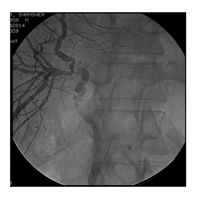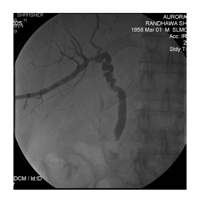Management issues in post living donor liver transplant biliary strictures
- PMID: 27057304
- PMCID: PMC4820638
- DOI: 10.4254/wjh.v8.i10.461
Management issues in post living donor liver transplant biliary strictures
Abstract
Biliary complications are common after living donor liver transplant (LDLT) although with advancements in surgical understanding and techniques, the incidence is decreasing. Biliary strictures are more common than leaks. Endoscopic retrograde cholangiopancreatography (ERCP) is the first line modality of treatment of post LDLT biliary strictures with a technical success rate of 75%-80%. Most of ERCP failures are successfully treated by percutaneous transhepatic biliary drainage (PTBD) and rendezvous technique. A minority of patients may require surgical correction. ERCP for these strictures is technically more challenging than routine as well post deceased donor strictures. Biliary strictures may increase the morbidity of a liver transplant recipient, but the mortality is similar to those with or without strictures. Post transplant strictures are short segment and soft, requiring only a few session of ERCP before complete dilatation. Long-term outcome of patients with biliary stricture is similar to those without stricture. With the introduction of new generation cholangioscopes, ERCP success rate may increase, obviating the need for PTBD and surgery in these patients.
Keywords: Biliary complications; Biliary strictures; Endoscopic retrograde cholangiopancreatography; Living donor liver transplant; Percutaneous transhepatic biliary drainage.
Figures










Similar articles
-
Endoscopic management of post-liver transplant billiary complications: A prospective study from tertiary centre in India.Indian J Gastroenterol. 2016 Jan;35(1):48-54. doi: 10.1007/s12664-016-0625-4. Epub 2016 Feb 13. Indian J Gastroenterol. 2016. PMID: 26873087
-
Percutaneous Transhepatic Biliary Drainage for Biliary Stricture After Endotherapy Failure in Living Donor Liver Transplantation: A Single-Centre Experience from India.J Clin Exp Hepatol. 2019 Nov-Dec;9(6):684-689. doi: 10.1016/j.jceh.2019.03.004. Epub 2019 Mar 25. J Clin Exp Hepatol. 2019. PMID: 31889748 Free PMC article.
-
Endoscopic management of biliary strictures after living donor liver transplantation.Clin J Gastroenterol. 2017 Aug;10(4):297-311. doi: 10.1007/s12328-017-0754-z. Epub 2017 Jun 9. Clin J Gastroenterol. 2017. PMID: 28600688 Review.
-
Percutaneous transhepatic biliary drainage may serve as a successful rescue procedure in failed cases of endoscopic therapy for a post-living donor liver transplantation biliary stricture.Gastrointest Endosc. 2009 Jan;69(1):38-46. doi: 10.1016/j.gie.2008.03.1113. Epub 2008 Jul 16. Gastrointest Endosc. 2009. PMID: 18635177
-
Current diagnosis and treatment of benign biliary strictures after living donor liver transplantation.World J Gastroenterol. 2016 Jan 28;22(4):1593-606. doi: 10.3748/wjg.v22.i4.1593. World J Gastroenterol. 2016. PMID: 26819525 Free PMC article. Review.
Cited by
-
Paradigm shift in the management of bile duct strictures complicating living donor liver transplantation.Indian J Gastroenterol. 2019 Dec;38(6):488-497. doi: 10.1007/s12664-019-01000-2. Epub 2020 Feb 17. Indian J Gastroenterol. 2019. PMID: 32065353
-
Indian College of Radiology and Imaging Evidence-Based Guidelines for Percutaneous Image-Guided Biliary Procedures.Indian J Radiol Imaging. 2021 Apr;31(2):421-440. doi: 10.1055/s-0041-1734222. Epub 2021 Jul 28. Indian J Radiol Imaging. 2021. PMID: 34556927 Free PMC article. Review.
-
Optimal Intervention for Initial Treatment of Anastomotic Biliary Complications After Right Lobe Living Donor Liver Transplantation.Transpl Int. 2022 Apr 22;35:10044. doi: 10.3389/ti.2022.10044. eCollection 2022. Transpl Int. 2022. PMID: 35529595 Free PMC article.
-
Management of biliary complications after LDLT.Updates Surg. 2024 Sep 14. doi: 10.1007/s13304-024-01988-z. Online ahead of print. Updates Surg. 2024. PMID: 39276196
-
Biliary complications after liver transplantation: current perspectives and future strategies.Hepatobiliary Surg Nutr. 2021 Jan;10(1):76-92. doi: 10.21037/hbsn.2019.09.01. Hepatobiliary Surg Nutr. 2021. PMID: 33575291 Free PMC article. Review.
References
-
- Nacif LS, Bernardo WM, Bernardo L, Andraus W, Torres L, Chaib E, D’Albuquerque LC, Maluf-Filho F. Endoscopic treatment of post-liver transplantation anastomotic biliary stricture: systematic review and meta-analysis. Arq Gastroenterol. 2004;51:240–249. - PubMed
-
- Sharma S, Gurakar A, Jabbour N. Biliary strictures following liver transplantation: past, present and preventive strategies. Liver Transpl. 2008;14:759–769. - PubMed
-
- Sugawara Y, Sano K, Kaneko J, Akamatsu N, Kishi Y, Kokudo N, Makuuchi M. Duct-to-duct biliary reconstruction for living donor liver transplantation: experience of 92 cases. Transplant Proc. 2003;35:2981–2982. - PubMed
-
- Gondolesi GE, Varotti G, Florman SS, Muñoz L, Fishbein TM, Emre SH, Schwartz ME, Miller C. Biliary complications in 96 consecutive right lobe living donor transplant recipients. Transplantation. 2004;77:1842–1848. - PubMed
Publication types
LinkOut - more resources
Full Text Sources
Other Literature Sources

